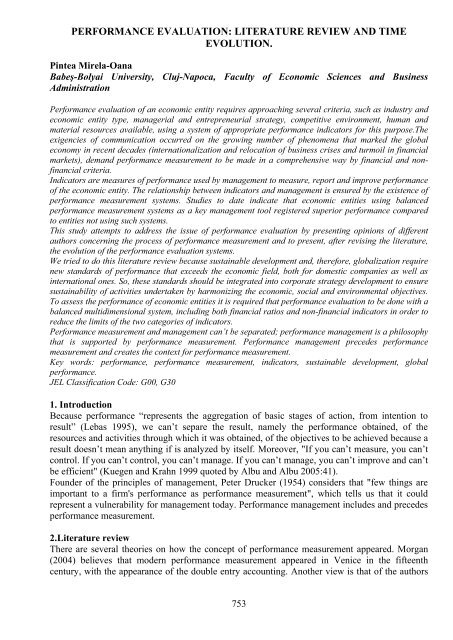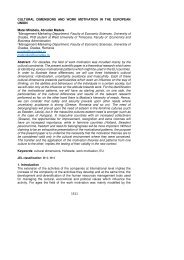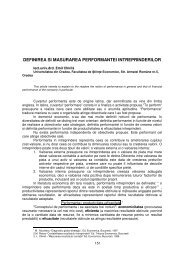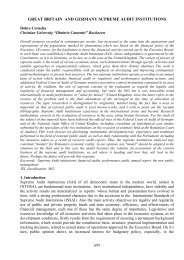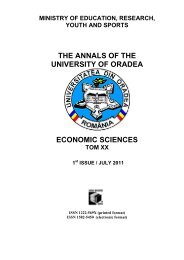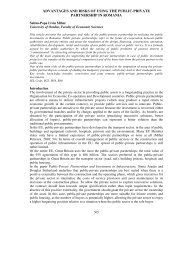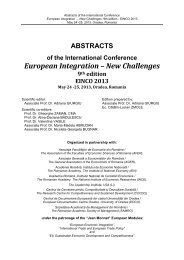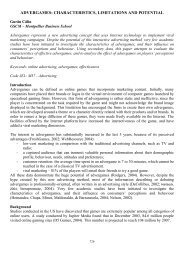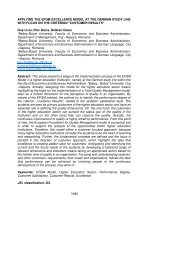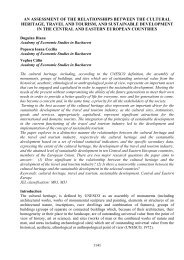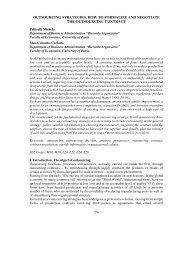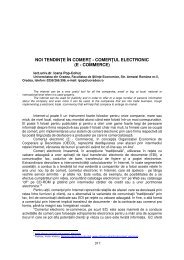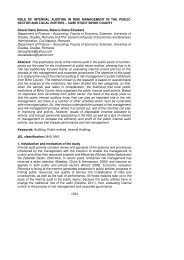performance evaluation: literature review and time evolution.
performance evaluation: literature review and time evolution.
performance evaluation: literature review and time evolution.
Create successful ePaper yourself
Turn your PDF publications into a flip-book with our unique Google optimized e-Paper software.
Johnson <strong>and</strong> Kaplan (1987) that consider that <strong>performance</strong> measurement appeared during theindustrial r<strong>evolution</strong>. Either way we can say with fair certainty that <strong>performance</strong> management hasemerged as the dominant research area in the early '50s, when academics <strong>and</strong> practitioners havebecome interested in the need to measure <strong>performance</strong> <strong>and</strong> measurement consequences (Argyris,1952, Ridgway, 1956).Interest in management <strong>and</strong> <strong>performance</strong> measurement has increased considerably in the last 20years (Taticchi, 2008). Number of publications on this topic has grown significantly over the lastdecade (Beamon 1999, Lohman et al. 2004, Gunasekaran et al. 2004). We believe that this ismainly due to a fundamental change in business. Furthermore, <strong>performance</strong> is not a subject easilyaddressed. It is clear the need to study <strong>and</strong> rethink the concept <strong>and</strong>, in this context, to rethink how<strong>performance</strong> measurement it is done.According to Atkinson et al. (1997) <strong>performance</strong> measurement should help the economic entityto underst<strong>and</strong> <strong>and</strong> assess the value received from suppliers <strong>and</strong> employees, the value provided bythe stakeholders <strong>and</strong> the effectiveness of processes implemented in the economic entity <strong>and</strong> itsstrategic properties. Therefore, we can say that <strong>performance</strong> measurement plays the role ofcoordination, monitoring <strong>and</strong> diagnosis of economic entity's activities.Marr (2004) distinguishes the following activities in the process of measuring <strong>performance</strong>: (1)building a model of <strong>performance</strong> for each business separately, (2) data collection, (3) dataanalysis <strong>and</strong> interpretation, (4) retrieval <strong>and</strong> communication information. Such a definition of<strong>performance</strong> measurement is more comprehensive than those mentioned above. Thus, Marrmanages to emphasize that <strong>performance</strong> measurement is a structured process, focused on results.Another answer to the question "What is <strong>performance</strong> <strong>evaluation</strong>?" is provided by MariaNiculescu in "Global Strategic Diagnostics", where it considers that "<strong>performance</strong> measurementis a process that allows you to connect an abstract concept to empirical indicators" (Niculescu2005:246). So, <strong>performance</strong> measurement tools are established to be the indicators. Theeconomic <strong>literature</strong> can account for dozens of definitions of indicators. Un indicator is an elementor a set of information elements, representative in relation to a concern or an objective, resultedfrom tangible measuring or observing a state of a phenomenon or an output (Boldeanu, 2008:24).Since the <strong>performance</strong> of an economic entity is influenced by various factors we consider that theindicators used to assess the <strong>performance</strong> have to cover all <strong>performance</strong> determinants <strong>and</strong> theirinfluence on <strong>performance</strong> by highlighting the quantifiable aspects <strong>and</strong> also the unquantifiableones. The measure "financial" or "non-financial" has not such a great importance <strong>and</strong> there is nostrict rule on the matter. Relevant criteria are different (strategic relevance, operationalefficiency) <strong>and</strong> can be met, as appropriate, by the financial indicators <strong>and</strong> / or non-financial(Lorino 2002: 237). The so-called "non-financial indicators”, even if they can’t always beexpressed in monetary units, their effect is reflected in other indicators of economic <strong>and</strong> financialdimension whose size is easily translated in monetary units. Improving the quality of the entity’sactivity is acting on the entity’s image (non-financial indicator), but also on the size of turnover.Currently <strong>performance</strong> measures should meet the following requirements (Maskell 1992:44-48):to use primarily the non-financial techniques; to vary from one location to another, from oneregion to another; to change over <strong>time</strong>, as entity needs change <strong>and</strong> to improve <strong>performance</strong>, notjust monitor <strong>performance</strong>.Performance <strong>evaluation</strong> of an economic entity requires approaching several criteria, such asindustry <strong>and</strong> economic entity type, managerial <strong>and</strong> entrepreneurial strategy, competitiveenvironment, human <strong>and</strong> material resources available, using a system of appropriate <strong>performance</strong>indicators for this purpose (Petrescu 2008:281).The management of an economic entity uses indicators to measure, report <strong>and</strong> improve entity’s<strong>performance</strong>. The relationship between indicators <strong>and</strong> management is ensured by the existence of<strong>performance</strong> measurement <strong>and</strong> can be captured as in figure number 1.754
Figure no. 1 Relationship between <strong>performance</strong> indicators <strong>and</strong> <strong>performance</strong> managementSource: the authorThe exigencies of communication occurred on the growing number of phenomena that markedthe global economy in recent decades (internationalization <strong>and</strong> relocation of business crises <strong>and</strong>turmoil in financial markets), dem<strong>and</strong> <strong>performance</strong> measurement to be made in a comprehensiveway by financial <strong>and</strong> non-financial criteria. Non-financial criteria take into account the entity’slong-term orientation <strong>and</strong> they derive from aspects such as social responsibility (Mironiuc2009:152).In the current context of sustainable development, <strong>performance</strong> <strong>evaluation</strong> process should takeinto account the interests of all parties involved (Kubiak 2003:41): internal <strong>and</strong> externalcustomers, suppliers, partners, investors, society as a whole. Thus, indicators of the economicentity's <strong>performance</strong> <strong>evaluation</strong> that should be included in the set of indicators indicated by Evans(2005) can be divided into the following categories (Paunescu 2007:19): "financial indicators;indicators reflecting the overall <strong>performance</strong> of an economic entity; indicators reflecting on themarket <strong>performance</strong> of the entity; indicators for quality of products <strong>and</strong> services; indicators oncustomer relationships; indicators on human resources <strong>and</strong> indicators for social responsibility <strong>and</strong>ethical behavior."As we have seen during the <strong>literature</strong> revised, research to date in order to identify the appropriatestructure of a system for assessing the <strong>performance</strong> of economic entities have found that it takes a"set of indicators that reflect a balanced picture of entities’ <strong>performance</strong>" (Ciobanu 2006:13) <strong>and</strong>reflecting the multidimensional nature of <strong>performance</strong>. An example is provided by Kaplan <strong>and</strong>Norton that offer the Balanced Scorecard in 1996, which is a balanced assessment of theeconomic entity's <strong>performance</strong>, including both financial <strong>and</strong> non-financial indicators.According to Epstein <strong>and</strong> Manzoni "systems (models) for measuring <strong>performance</strong> should includemore non-financial indicators to complement the financial ones, in particular with regard tocustomer perception <strong>and</strong> <strong>performance</strong> of internal processes" (Epstein <strong>and</strong> Manzoni, 1997).For sustainable development of an entity, value creation can’t be seen in strictly financial terms,therefore any strategies that are defined by entities concerns not only the quantitative aspects(economic-financial) but also qualitative aspects (social <strong>and</strong> environmental). Based on theseaspects Global Reporting Initiative proposed a set of <strong>performance</strong> measures covering the threedimensions of overall <strong>performance</strong>, divided into: environmental indicators, social indicators <strong>and</strong>economic indicators.3.Research methodologyIn terms of working tools for collecting data, the most used method of research was thelongitudinal method, by presenting the <strong>time</strong> <strong>evolution</strong> of the concepts discussed in the paper. Interms of research techniques <strong>and</strong> procedures used most frequently was <strong>review</strong>ing the <strong>literature</strong>regarding the concept of <strong>performance</strong> measurement <strong>and</strong> the systems for <strong>performance</strong> <strong>evaluation</strong>.4. Results of the researchFor an economic entity to achieve higher <strong>performance</strong> is necessary to implement an effective<strong>performance</strong> measurement system that "would allow for reaching decisions <strong>and</strong> actingaccordingly because it quantifies the efficiency <strong>and</strong> effectiveness of past actions through the755
acquisition, collection, sorting, analyzing, interpreting <strong>and</strong> dissemination of appropriate data"(Neely 1998:5-6). This definition is important because it indicates that a <strong>performance</strong>measurement system has several components, namely: individual measures that quantify theefficiency <strong>and</strong> effectiveness of actions; a set of measures that combined assess overall<strong>performance</strong> of an economic entity <strong>and</strong> the support infrastructure that allows data to be obtained,collected, sorted, analyzed, interpreted <strong>and</strong> disseminated.In the next table we present the <strong>evolution</strong> of <strong>performance</strong> measurement systems while achievinga <strong>review</strong> of the <strong>literature</strong>. The main purpose of such systems is to support the economic entity'smanagement to measure <strong>performance</strong>, analyze <strong>and</strong> improve operational efficiency by improvingdecision-making process. Most systems had empirical testing <strong>and</strong> some of them have beendeveloped only in theory.Table no. 1 Systems for measuring <strong>performance</strong>Period Model (System) Author(s)Before the ’80 ROI, ROE, ROCE, derivate Simons (2000)1980 Economic Value Added (EVA) Stewart (2007)1988 Activity Based Costing (ABC) şi Activity Based Cooper <strong>and</strong> Kaplan (1988)Management (ABM)1988 Strategic Measurement Analysis <strong>and</strong> Reporting Technique Cross <strong>and</strong> Lynch (1988)(SMART)1989 Supportive Performance Measures (SPA) Keegan et al. (1989)1990 Customer Value Analysis (CVA) Customer Value Inc. (2007)1990 Performance Measurement Questionnaire (PMQ) Dixon et al. (1990)1991 Results <strong>and</strong> Determinants Framework (RDF) Fitzgerald et al. (1991)1992 Balanced Scorecard (BSC) Kaplan <strong>and</strong> Norton (1992)1994 Service-Profit Chain (SPC) Heskett et al. (1994)1995 Return on Quality Approach (ROQ) Rust et al. (1995)1996 Cambridge Performance Measurement Framework (CPMF) Neely et al. (1996)1996 Consistent Performance Measurement System (CPMS) Flapper et al. (1996)1997 Integrated Performance Measurement System (IPMS) Bititci et al. (1997)1998 Comparative Business Scorecard (CBS) Kanji (1998)1998 Integrated Performance Measurement Framework (IPMF) Medori <strong>and</strong> Steeple (2000)1999 Business Excellence Model (BEM) EFQM (2007)2000 Dynamic Performance Measurement System (DPMS) Bititci et al. (2000)2001 Action-Profit Linkage (APL) Epstein <strong>and</strong> Westbrook (2001)2001 Manufacturing System Design Decomposition (MSDD) Cochran et al. (2001)2001 Performance Prism (PP) Neely et al. (2001)2004 Performance Planning Value Chain (PPVC) Neely <strong>and</strong> Jarrar (2004)2004 Capability Economic Value of Intangible <strong>and</strong> Tangible Ratnatunga et al. (2004)Assets Model (CEVITAe)2006 Performance, Development, Growth Benchmarking System(PDGBS)St-Pierre <strong>and</strong> Delisle (2006)2007 Unused Capacity Decomposition Framework (UCDF) Balach<strong>and</strong>ran et al. (2007)Source: Taticchi, 2010:10In the ’80 the SMART model, developed in 1988, is a significant change in the <strong>literature</strong> on<strong>performance</strong> measurement, focusing first on linking strategy to operations by internal <strong>and</strong>external <strong>performance</strong> measures, <strong>and</strong> modeling the economic entity as an integrated system. Thenext, the SPA model, is characterized by the introduction of two innovations, which are: theconcept of balanced measures <strong>and</strong> use of non-financial indicators.In the 1990s, many <strong>performance</strong> measurement systems have emerged attempting to provideintegrated solutions (RDF, BSC, SPC, IPMS, CBS, IPMF <strong>and</strong> BEM) or only specificmethodologies to solve problems (PMQ, ROQ, CPMF <strong>and</strong> CPM s). These were followed by BSC756
model that included more features, such as financial <strong>and</strong> non-financial, to bring into focus a mixof <strong>performance</strong> measures.Systems that have emerged since 2000 are continuing to improve underst<strong>and</strong>ing of <strong>performance</strong>measurement process. Recently developed systems have specific features to connect strategy tooperations carried out, providing a balanced set of measures (both financial <strong>and</strong> non-financial), inan attempt to create quantitative relations incorporating <strong>performance</strong> indicators <strong>and</strong> addressing<strong>performance</strong> measurement as a cognitive process.5. ConclusionsIn the '80s <strong>and</strong> early '90s various authors have suggested different systems to manage<strong>performance</strong> of economic entities among which the following: <strong>performance</strong> measurement matrix(Keegan et al. 1989), <strong>performance</strong> pyramid (Lynch <strong>and</strong> Cross 1991), results <strong>and</strong> determinantsmatrix (Fitzgerald et al. 1991), balanced scorecard (Kaplan <strong>and</strong> Norton 1992), <strong>performance</strong>measurement process developed at Cambridge University (Neely et al. 1995) <strong>and</strong>, more recently,there was the <strong>performance</strong> prism (Neely et al. 2001, 2002). All these have led to a relevantresearch area related to how these <strong>performance</strong> measurement systems can be developed <strong>and</strong>improved.From the <strong>literature</strong> <strong>review</strong> we found that there is a continuing concern about the <strong>performance</strong>measures <strong>and</strong> its measure in all areas of activity, wanting to capture the <strong>performance</strong> of aneconomic entity it in a comprehensible form. To obtain a relevant <strong>and</strong> coherent picture on the<strong>performance</strong> of an economic entity is necessary to use a system of indicators. The <strong>performance</strong>indicators of its structure must reflect in the same <strong>time</strong>, at least the following aspects: entity'sobjectives, its strategy, efficiency <strong>and</strong> effectiveness of the entity's activities, the ability to adapt tothe market in which it operates.ReferencesBooks:Albu, Nadia <strong>and</strong> Albu, Catalin.Instrumente de management al performanței, vol.I Contabilitatede gestiune. Bucureşti: Editura Economică, 2003.Albu, Nadia <strong>and</strong> Albu, Catalin.Instrumente de management al performanței,, vol.II Control degestiune. Bucureşti: Editura Economică, 2003.Argyris, C. The Impact of Budgets on People. New York:Controllership Foundation, 1952.Atkinson, Anthony A., Kaplan, Robert S., Young, S. Mark. Management Accounting.. PrenticeHall, 2004.Boldeanu, Dana, Maria. Sistem informatic pentru analiza performanțelor economico-financiarela nivel macroeconomic. Teză de doctorat, ASE Bucureşti, 2008.Ciobanu, Aanamaria. Analiza performanței întreprinderii. Bucureşti: Editura ASE, teză dedoctorat, 2006.Drucker, Peter. The Practice of management. New York: Harper & Row,1954.Evans, J.R, Lindsay, W.M. The Management <strong>and</strong> Control of Quality. Ohio:Sixth EditionMason,2005.Epstein, Marc <strong>and</strong> Manzoni, Jean—Francois, (1997). The Balanced Scorecard <strong>and</strong> Tableau deBord: Translating Strategy Into Action, Management Accounting Vol. 79, 2 (1997).Fitzgerald, L., Johnson, R., Brignall, S., Silvestro R., Voss, C. Performance Measurement inService Business. London:CIMA, 1991.Kaplan, R.S.,Norton, D.P. The Strategy-Focused Organisation. Cambridge, MA: HarvardBusiness School Press, 2001.Lynch, R.L., Cross, K.F. Measure Up. Cambridge, MA: Blackwell, 1991.Lorino, Philippe. Metodes et pratiques de la <strong>performance</strong>. Le pilotage par les processus et lescompetences. Paris: Editions d’organisation, 2002.757
Marr, Bernard. Strategic Performance Management. Leveraging <strong>and</strong> measuring your intangiblevalue drivers. Butterworth-Heinemann, 2006.Mironiuc Marilena. Analiza financiara versus analiza extra-financiara in masurareaperformantelor intreprinderii durabile. Supliment of Theoretical <strong>and</strong> applied economics Revue,Bucharest, 2009.Neely, A.D., Adams, C., Kennerley, M. Performance Prism: The Scorecard for Measuring <strong>and</strong>Managing Stakeholder Relationships. Harlow: Prentice-Hall Financial Times, 2002.Niculescu, Maria. Diagnostic global strategic, vol II, Diagnostic financiar. Bucuresti: EdituraEconomică, 2005.Petrescu, S. Analiză şi diagnostic financiar-contabil. Ghid teoretico-aplicativ, ediția a II-a,revizuită şi adăugită. Bucureşti: Editura CECCAR, 2008.Working papersBeamon, B.M. Measuring supply chain <strong>performance</strong>. International Journal of Operations &Production Management, Vol. 19, 1999:275.Gunasekaran, A., Patel C.,McGaughey R.E. A framework for supply chain <strong>performance</strong>measurement. International Journal of Production Economics, Vol. 87, No. 3, 2004:333-47.Kaplan, R.S., Norton, D. Having trouble with your strategy? Then map it. Harvard BusinessReview, 2000:167-176.Keegan, D.P., Eiler R.G.,Jones C.R. Are your <strong>performance</strong> measures obsolete?. ManagementAccounting, 1989:45-50.Lebas, M. Oui, il faut définir la <strong>performance</strong>. Revue Française de Comptabilité, Nr. 226, 1995.Maskell, B. Performance measurement for world class manufacturing. Corporate Controller(COP), 1992: 44–48.Neely A.D., Gregory M.,Platts K. (1995), “Performance measurement system design: a <strong>literature</strong><strong>review</strong> <strong>and</strong> research agenda”, International Journal of Operations & Production Management,Vol. 15 No. 4, p. 80-116, 1995.Neely, A.D., Adams, C.,Crow,e P. The <strong>performance</strong> prism in practice. Measuring BusinessExcellence, Vol. 5 No. 2, 2001:6-12.Păunescu, C. Îmbunătățirea continuă a calității: indicatori de performanță. Calitate şiManagement, Nr.1, anul 5, 2006.Ridgway, V.F. Dysfunctional consequences of <strong>performance</strong> measurements. AdministrativeScience Quarterly, Vol. 1 No. 2, 1956: 240-7.Taticchi, P., Balach<strong>and</strong>ran, K., Botarelli, M.,Cagnazzo, L. Performance measurement <strong>and</strong>management for small <strong>and</strong> medium enterprises: an integrated approach. Journal of AppliedManagement <strong>and</strong> Accounting Research, Vol. 5 No. 2, 2008:57-72..Taticchi, P., Tonelli, F.,Cagnazzo L. Performance measurement <strong>and</strong> management: a <strong>literature</strong><strong>review</strong> <strong>and</strong> a research agenda. Measuring Business Excellence,vol. 14, no.1, 2010: 4-18.758


